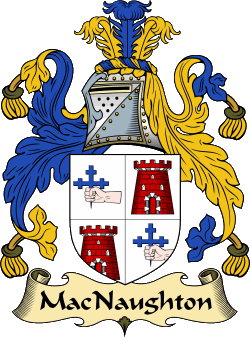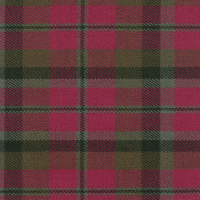MacNaghten

Purchase Heraldry Products
Download Now!

Surname: MacNaghten
Branch: MacNaghten
Origins: Scottish
More Info: Scotland
|
|
Background: The name MacNaughton comes from the Pictish Nechton meaning "the pure one". Clan Nechtan were established in Strathtay in the 12th century, probably transferred there from Moray by Malcolm IV, but their possessions extended over the upper part of Loch Awe, Glenarn, Glenshira and Loch Fyne. Gilchrist MacNaughton was granted the castle and island of Fraoch Eilean in Loch Awe by Alexander III in 1267. In addition, Gilchrist also held Dunderave on Loch Fyne and the castle of Dubh Loch in Glenshira. As the MacNaughtons were allied to the MacDougalls of Lorne, their chief Donald MacNaughton opposed Robert the Bruce (as did the Comyns in the north). On Robert becoming King, the MacNaughtons lost many of their lands in Argyll to the Campbells. However Donald's son, Duncan, loyally supported King David II, who rewarded his son Alexander with lands in the Isle of Lewis. Sir Alexander, chief of the clan during the reign of James IV fell with his King at Flodden in 1513. The MacNaughtons continued to be loyal to the Stewarts both during the wars of Charles I and at the revolution of 1688 that overthrew James VII, for which they lost their estates in 1691. The 17th and last chief of the MacNaughtons was John of Dundarave who fell out with Campbell of Ardkinglas whose daughter he was to marry. MacNaughton thought he was to marry the younger daughter with whom he was in love, however after taking too much refreshment prior to the ceremony he discovered he'd been wed to the eldest daughter. On realising his predicament he promtly deserted his wife and eloped to Ireland with his love, the second daughter. Ardkinglas gained possession of the MacNaughton estates on the grounds of incest and the chiefship became vacant. In 1818, the Lord Lyon King of Arms accepted Edmund A MacNaghton of Bushmills Co. Antrim as chief of the clan and its his descendant Sir Patrick Macnaghton of that Ilk and Dundarave Co. Antrim who is the present-day chief.
|
 Motto: Motto: I hope in God . Arms: Quarterly, 1st & 4th, Argent, a dexter hand fessways Proper holding a cross crosslet fitchee Azure; 2nd & 3rd, Argent, a tower embattled Gules. Crest: A tower embattled Gules. Supporters: (on a compartment embellished with trailing azalea Proper) Two roebucks Proper. Badge: A sprig of trailing azalea Proper. Plant: Trailing azalea Proper. View the Heraldry Dictionary for help.

The Macnaghtens are one of the clans who claimed descent from the great Pictish rulers of Moray. The name Nechtan, which may mean "pure" or "clear," was popular in at least one branch of the Pictish royal line. In the thirteenth century there are records of three brothers, Gilchrist, Athe and Gilbert, the sons of Malcolm Macnachten. Gilchrist received from Alexander III a charter in 1267 granting him the keepership of a castle warding the narrow Pass of Brander, the gateway to the west.
By coming to Loch Awe, the Macnachtens became neighbours of the powerful and acquisitive Campbells. When Robert the Bruce set out to gain the throne, the Campbells were quick to come to his support while the Macnachtens, under the influence of Macdougalls, opposed him. Macnachtens formed part of the Macdougall host that fought against Bruce's army at the Pass of Brander in 1306, and later at Dalrigh near Tyndrum. The Macnachtens appear to have changed their allegiance and a Baron Macnachten, possibly Alexander of that Ilk, is recorded fighting at Bannockburn in 1314. The Macnachtens gained little from their late change of heart, and from that point on the Campbells dominated Loch Awe. Alexander, the chief who may have fought at Bannockburn, took for his second wife Christina Campbell. When she was widowed in 1361, Christina granted to her cousin, Sir Colin Campbell of Lochow, her marriage portion of one third of the Macnachten lands. Alexander's son, Duncan, succeeded to the remaining lands. He made his seat at Dunderave, which was thereafter the territorial designation of the chiefs. In 1478, Duncan's heir, Alexander, acknowledged the Campbell Earls of Argyll as feudal superiors and accepted a charter to his lands from the earl's hands. His grandson, yet another Alexander, was knighted by James IV and followed the king to Flodden in 1513, where he was one of the few survivors. He died two years later. He had married twice and had six sons, the eldest of whom succeeded his grandfather in 1527. The second son, Ian, acted as tutor to his nephew and was the father of Ian, or John, Dhu, who may be the "Shane Dhu" credited with founding the Irish branch of the family.
In 1548 Gilbert Macnachten succeeded as chief. When he died without issue, the succession devolved upon his younger brother, Alexander. He started the rebuilding of Dunderave Castle on Loch Fyne and it was completed by his son, lain, in 1596. In 1627 the Macnachten chiefs raised a force of bow-men to go to the siege of La Rochelle to assist the French Huguenot rebels in their fight against Cardinal Richelieu, effective ruler of France. The chief was in high favour at the court of Charles I, and served as a Gentleman of the Privy Chamber. However, the expense of the French expedition and the extravagance demanded by living at court forced Macnachten to mortgage his lands.
Alexander died in 1630, followed shortly afterwards by his childless heir, leaving Dunderave in the hands of Alexander's brother, Malcolm of Killearn. Malcolm's son, Alexander, was a fervent royalist, and when he succeeded to the chiefship he called out his clansmen, accompanied by Argyll's son, for the abortive rising against the Cromwellian occupation led by the EarI of Glencairn in 1653. The expedition was sheer folly, and earned Macnachten the enmity of Argyll. He was knighted after the Restoration in 1660, but through Argyll's influence he was later denounced as an outlaw. The lands were almost entirely lost through debt, and lain, the next chief, who succeeded in 1685, inherited little more than an empty title. He joined the forces of Graham of Claverhouse, the "Bonnie" Viscount Dundee, fighting for James VII at Killiecrankie in 1689. He was denounced as a Jacobite rebel, and his remaining lands were forfeited. His younger son, John, was the last chief of this line. He was forced to make a formal disposition of the remainder of the estate in 1710 to Sir James Campbell of Ardkinglas. He died leaving no legitimate heir.
John Macnaughten, known as "Shane Dhu," appeared in Ireland as secretary to his kinsman, the Earl of Antrim, in 1580. On the extinction of the Dunderave line his greatgrandson, Edmond, was pressed to become chief. He declined, but his son, Edmund Alexander, was recognised as chief in 1818. When he died in 1832 he was succeeded by his brother, Francis, who was a judge in Madras and Calcutta. He was created a baronet in 1836. Sir Edward, fourth Baronet, was a distinguished lawyer who became a Lord of Appeal in 1887 with the life peerage of "Baron Macnaghten of Runkerry." He was succeeded by his son, Sir Edward, whose sons both succeeded to the title, but were killed in the First World War. Sir Francis, eighth Baronet, succeeded his nephews, and is the father of the present chief.
Name Variations: Ayson, Bissett, Easson, Ferguson, Henderson, Hendrie, Hendry, Henerdie, Henerdy, Henrie, Henry, Kendrich, Kendrick, Kinrick, MacAire, MacAirey, MacAirie, MacAiry, MacAnir, MacAry, MacAys, MacBrayn, MacBrayne, MacBreen, MacBrine, MacBrinn, MacCachren, MacCarhy, MacCarie, MacCarken, MacCarrie, MacCarry, MacCavic, MacCavick, MacCeol, MacClackuon, MacCoal, MacColl, MacCrackan, MacCrackans, MacCracken, MacCracken, MacCrackens, MacCrackin, MacCrackin, MacCrackins, MacCracktin, MacCracktine, MacCraken, MacCratic, MacCratick, MacCrocken, MacCrocklin, MacEal, MacEel, MacFergusse, MacGrachin, MacGrattan, MacGratten, MacGrattin, MacGreachain, MacGreachan, MacHanvichar, MacHarrie, MacHarry, MacHendrie, MacHendry, MacHenrie, MacHenry, MacImery, MacImmery, MacInerie, MacInery, MacInrye, MacIntaylor, MacInterrie, MacInterry, MacIntrye, MacKay, MacKendrich, MacKendrick, MacKendricks, MacKenerick, MacKenerie, MacKenery, MacKindrick, MacKindricks, MacKinrick, MacKnatt, MacKneight, MacKnigh, MacKnight, MacKnot, MacKracherne, MacMath, MacMitt, MacNac, MacNachdan, MacNachtan, MacNachten, MacNachton, MacNack, MacNagen, MacNaghtan, MacNaghten, MacNaghtin, MacNaight, MacNair, MacNairy, MacNamell, MacNammill, MacNarie, MacNary, MacNatt, MacNattie, MacNatton, MacNatty, MacNauchton, MacNaugh, MacNaught, MacNaughtan, MacNaughten, MacNaughton, MacNayer, MacNayre, MacNear, MacNeid, MacNeight, MacNeir, MacNerie, MacNery, MacNet, MacNete, MacNett, MacNette, MacNetten, MacNetton, MacNeur, MacNevens, MacNevin, MacNevins, MacNight, MacNitt, MacNivan, MacNivans, MacNiven, MacNorton, MacNott, MacNought, MacNoughtan, MacNoughton, MacNoyer, MacNuir, MacNut, MacNutt, MacNuyer, MacPortland, MacQuaig, MacQuake, MacQuaker, MacRac, MacRack, MacRacken, MacRackin, MacRagan, MacRaggan, MacReachain, MacReachan, MacRuck, MacRucke, MacVicar, MacVickar, MacVickars, MacVicker, MacVickers, MacVig, MacVige, MacVrine, MacVryne, MacWaughton, MacYole, MacYoll, Manaugh, Mannice, Mannis, Mannise, Nachtan, Nachten, Nactan, Nacten, Naghton, Natton, Naughten, Naughtie, Naughton, Naughty, Nechtan, Nechten, Nectan, Necten, Nevin, Nevins, Nevinson, Niven, Nivens, Nivenson, Nought, Nucater, Nucator, Nutt, Porter, Weir.
References:One or more of the following publications has been referenced for this article.The General Armory; Sir Bernard Burke - 1842.
A Handbook of Mottoes; C.N. Elvin - 1860.
Scottish Clans and Tartans; Neil Grant - 2000.
Scottish Clan and Family Encyclopedia; George Way of Plean and Romilly Squire - 1994.
Scottish Clans and Tartans; Ian Grimble - 1973.
World Tartans; Iain Zaczek - 2001.
Clans and Families of Scotland; Alexander Fulton - 1991.
Scottish American Society: http://www.scottishamericansociety.org/id23.html

|
|

The beautiful heraldry artwork for this family is available to purchase on select products from the Celtic Radio Store. We look forward to filling your order!

|
|

|

Modern | 
Weathered |
|
|
|